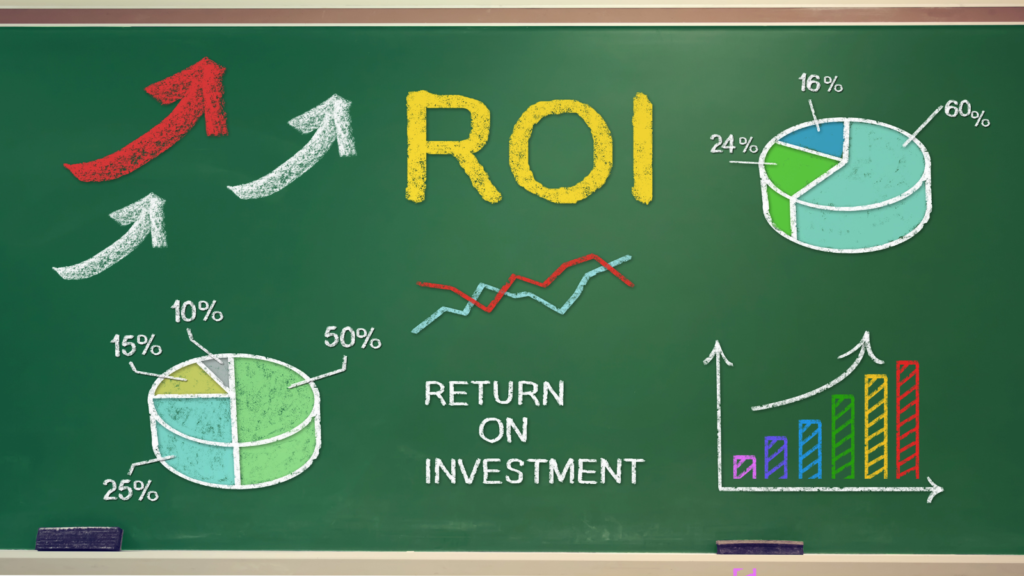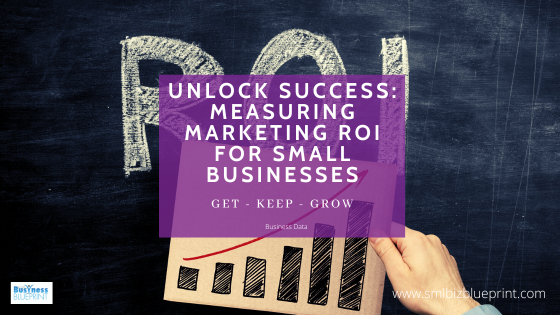Welcome, fellow business owners, to a journey that holds the keys to transforming your marketing efforts from a shot in the dark to a targeted strategy with measurable results.
We understand the challenges you face when it comes to evaluating the success of your marketing campaigns. How do you know if the money and effort you pour into marketing truly pays off?

In this guide, we will unravel the secrets of measuring your marketing ROI effectively.
Prepare to gain insights that will empower you to take informed actions, boost your revenue, and maximise the return on your marketing investment.
Understanding ROI in Marketing
Let’s begin by understanding what ROI in marketing truly means.
Return on Investment, or ROI, is more than just a financial metric – it’s a compass that guides your marketing endeavours. Think of it as a litmus test for the efficiency and profitability of your campaigns.
ROI helps determine how many dollars you get back for every dollar you invest. This crucial metric enables you to allocate resources wisely and optimise your marketing strategies.
Actions:
Define Clear Objectives:
Before embarking on any campaign, define what success looks like. Is it increased sales, brand awareness, or lead generation? Having specific objectives makes it easier to measure ROI accurately.
Calculate Total Costs:
Include not just the direct costs of marketing but also hidden expenses like software subscriptions, employee time, and overhead. A comprehensive cost calculation provides a more realistic ROI.
Distinguish Short-term and Long-term ROI:
Remember that ROI isn’t only about immediate returns. Consider how a campaign’s impact might extend over time, affecting customer retention and long-term revenue.
Setting Clear Goals and Objectives
Setting clear and specific marketing campaign goals is the first step toward maximising ROI.
Defining your objectives provides a solid foundation for measuring success, whether you aim to increase website traffic, generate leads, or boost sales conversions.
Setting goals gives you direction and empowers your team to work cohesively towards a common purpose. As the saying goes, “A goal without a plan is just a wish.”
Actions
SMART Goal Setting:
Employ the SMART (Specific, Measurable, Achievable, Relevant, Time-bound) framework to create well-defined and achievable goals.
Segment Your Goals:
Break it into smaller, actionable objectives instead of focusing on a single overarching goal. This approach allows you to track progress and make adjustments more effectively.
Align with Business Strategy:
Ensure your marketing goals align with your overall business strategy. This cohesion guarantees that your marketing efforts contribute directly to your company’s growth.
Selecting Key Performance Indicators (KPIs)
Key Performance Indicators, or KPIs, serve as your compass points on the journey to ROI maximisation.
They are quantifiable metrics that offer insight into the effectiveness of your marketing efforts. Among the essential KPIs are conversion rates, customer acquisition cost (CAC), customer lifetime value (CLV), and engagement metrics.
Each KPI provides a unique perspective on your campaign’s impact, allowing you to adjust your strategies accordingly.
Actions
Start with Relevant KPIs:
Not all KPIs are created equal. Choose metrics that align with your goals. For instance, if your goal is lead generation, track metrics like form submissions and downloads.
Focus on Quality Over Quantity:
Don’t drown in data. Concentrate on a handful of meaningful KPIs that truly reflect the impact of your campaigns. Quality data leads to informed decisions.
Use Comparative Analysis:
Benchmark your KPIs against industry standards or previous campaigns. This approach provides context and helps you gauge the success of your efforts more accurately.

Implementing Effective Tracking and Analytics
Accurate data collection is the cornerstone of ROI measurement.
Leveraging tools like Google Analytics, CRM systems, and social media insights equips you with invaluable information. These tools not only track your campaigns’ performance but also help you identify areas of improvement.
Customising dashboards and generating reports gives you a real-time view of your progress, ensuring you’re always one step ahead.
Actions
Utilise Google Tag Manager:
Implement Google Tag Manager to manage tracking codes and pixels across your website easily. This centralises tracking and reduces the need for constant developer intervention.
Set Up Conversion Goals:
Define clear conversion goals within your analytics platform. Whether it’s a completed purchase, form submission, or sign-up, tracking these goals helps measure campaign effectiveness.
Regularly Review Analytics:
Schedule regular reviews of your analytics data. Set aside dedicated time to analyse trends, identify bottlenecks, and discover opportunities for optimisation.
Attribution Models and Channel Analysis
Attribution models are your navigational charts in the complex sea of customer journeys.
They assign credit to different touchpoints that lead to conversions. Multi-channel attribution offers a comprehensive view of campaign effectiveness, allowing you to understand which channels contribute most to your ROI.
With consumers interacting across devices and platforms, accurately attributing ROI is a challenge worth conquering.
Actions
Experiment with Attribution Models:
Test different attribution models to see how they impact your understanding of campaign performance. Compare first-touch, last-touch, and multi-touch attribution to get a holistic view.
Segment by Channel:
Break down your data by marketing channel to identify which contributes most to conversions. This information helps allocate resources effectively and invest where it matters most.
Consider Time Lags:
Keep in mind that not all conversions happen immediately. Some may occur days or even weeks after the initial touchpoint. Use attribution insights to understand the true impact of each channel.
Calculating ROI
Now, let’s dive into the heart of ROI measurement – the calculation itself. The ROI formula [(Net Profit – Cost of Investment) / Cost of Investment] * 100 may seem straightforward, but the insights it reveals are profound.
Imagine investing $1000 in a campaign that generates $3000 in revenue. Your ROI is 200%, a testament to the power of effective marketing.
Remember, every percentage point matters; optimising campaigns for even a slight increase in ROI can significantly impact your bottom line.
However, remember that effective ROI calculation involves a more comprehensive approach. Consider the cost of your product or service, operational expenses, and other overheads to calculate your true profit. This comprehensive view ensures you’re making informed decisions based on accurate data.
Actions
Include All Costs:
When calculating ROI, ensure you include all costs, not just marketing expenses—factor in production, shipping, and customer support costs to get a comprehensive view of your investment.
Use Advanced ROI Metrics:
Explore Customer Lifetime Value (CLV) metrics to refine your ROI calculation. Knowing how much a customer is worth over time helps you assess the true impact of your campaigns.
Compare Campaigns:
Compare ROI across different campaigns to identify patterns and trends. This allows you to replicate successful strategies and avoid pitfalls that lead to lower ROI.

A/B Testing and Optimization
In the realm of ROI maximisation, A/B testing is your secret weapon.
It allows you to experiment with different elements of your campaigns – ad copy, visuals, landing pages – to identify what resonates best with your audience.
Suppose you run an A/B test on your email subject lines and discover that a personalised approach increases open rates by 20%. That’s 20% more potential conversions with a simple tweak.
Actions
Test One Variable at a Time:
When conducting A/B tests, change only one element. This isolates the impact of that change, providing clearer insights into what’s driving improved ROI.
Scale Successful Changes:
Don’t stop if an A/B test reveals a winning variation. Apply that winning element to other campaigns or channels to consistently improve ROI.
Leverage Multivariate Testing:
Consider moving to multivariate testing as you become more experienced with A/B testing. This allows you to test multiple variables simultaneously, providing a deeper understanding of user preferences.
Continuous Improvement Strategies
Embrace the iterative nature of marketing. Regularly analyse your results and make data-driven decisions to enhance future campaigns.
Creating a marketing feedback loop ensures you’re continuously learning and adapting. Imagine refining your strategies with each campaign, inching closer to the sweet spot where every dollar invested brings substantial returns.
Actions
Regularly Analyze Data:
Set up a regular cadence for reviewing campaign data. Weekly or monthly reviews ensure you react to immediate results and identify long-term trends.
Document Insights:
Maintain a record of your findings from each campaign. Document what worked, what didn’t, and the adjustments you made. This knowledge becomes invaluable for future campaigns.
Encourage Cross-Department Collaboration:
Gather insights from your marketing team, sales, customer support, and other departments. Their perspectives offer a well-rounded view of ROI impact.
Conclusion:
As we wrap up our journey through the intricacies of measuring and maximising ROI in your marketing efforts, remember this: ROI is more than just a metric; it’s your compass guiding you toward profitability and success.
You can turn every marketing dollar into a strategic investment by setting clear goals, selecting the right KPIs, implementing effective tracking, optimising through A/B testing, and embracing continuous improvement.
So, fellow business owners, it’s time to embark on your ROI odyssey. May your campaigns be profitable, your strategies be informed, and your journey be transformative.

FAQs:
Q: What is ROI in marketing, and why does it matter?
A: ROI measures the efficiency of your marketing campaigns by showing how much revenue they generate compared to their costs. It matters because it guides your decisions, helping you invest in strategies that bring the most value.
Q: How do I calculate ROI for my marketing campaigns?
A: Use the formula [(Net Profit – Cost of Investment) / Cost of Investment] * 100. For instance, if your campaign costs $1000 and generates $2500, your ROI is 150%.
Q: Why are KPIs important, and which ones should I focus on?
A: KPIs provide a clear picture of your campaign’s performance. Focus on conversion rates, CAC, CLV, and engagement metrics to gain insights into your marketing success.
Q: What is A/B testing, and how can it boost my ROI?
A: A/B testing involves comparing two versions of an element to identify what resonates with your audience. It can boost ROI significantly by fine-tuning your strategies based on real audience preferences.
Q: How can I continuously improve my ROI over time?
A: Embrace the feedback loop – regularly analyse campaign results, adjust strategies based on data, and always seek areas for optimisation.
Q: Why are case studies and real-world examples relevant to my journey?
A: Case studies showcase how businesses achieved remarkable ROI by implementing effective strategies. They offer practical insights you can apply to your own campaigns.
Q: What’s the next step after optimising my marketing ROI?
A: The journey doesn’t end here. Maximised ROI opens doors to scaling your strategies, exploring new avenues, and taking your business to greater heights.
In marketing, ROI isn’t just a metric – it’s a pathway to business growth.
By understanding, measuring, and optimising your ROI, you’re armed with the tools to make impactful decisions, boost revenue, and achieve your goals.
So, fellow business owners, take action now. Implement these strategies, witness the transformation, and let your ROI success story unfold. Your journey begins today.




